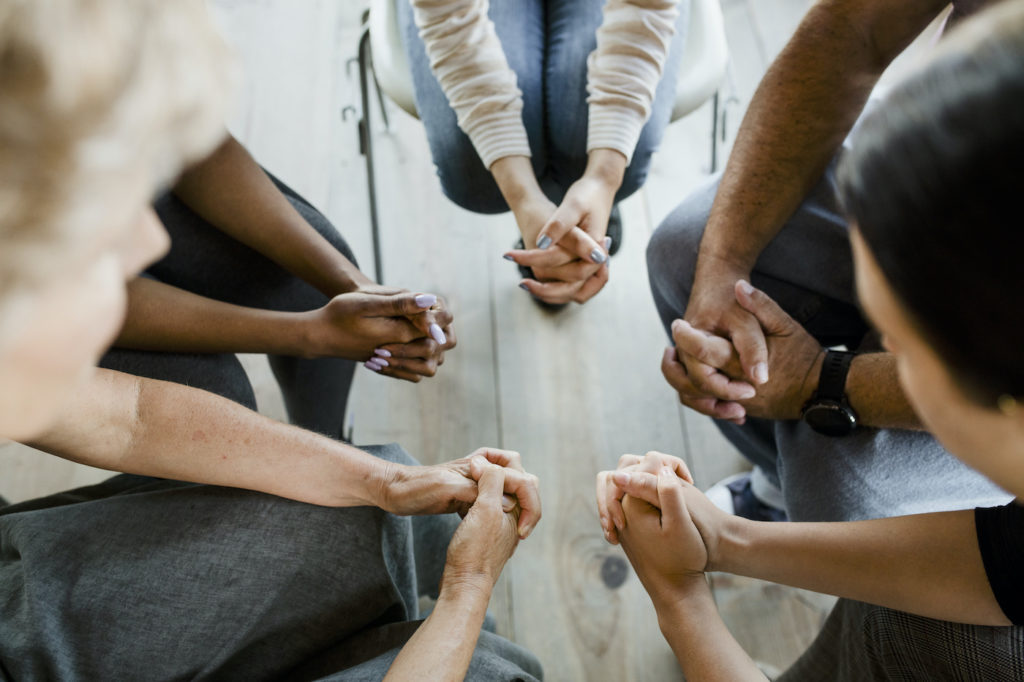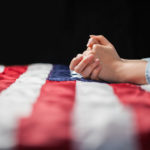The coronavirus pandemic has illuminated a truth taught by preachers and philosophers since ancient times: man is a social being, and it is not good for him to be alone. Many find it difficult to bear the isolation that the disease has imposed—to different degrees, of course. A gregarious fellow, alone in a tiny apartment, presumably has it worse than a reserved man at home with his family, a couple of dogs, an extensive personal library, a walkable neighborhood, and a well-stocked drinks cabinet.
But though the burdens of lockdown are unequally distributed, we all feel the curtailment of our social life and activities. We are not ourselves without others, because our individuality is rooted in our relationships. Whether in our casual participation in pick-up soccer or rec league softball, or in our intimate friendships and sacred religious observances, our relationships with others define and reveal our being. We rely on others to be fully ourselves, and this disease-induced isolation reminds us how precious the freedom to associate with others is.
Unfortunately, the Supreme Court has progressively dismantled legal protections for this constitutional freedom. For years the Court either has set it aside or subsumed it within other rights—rather than protect it for its own sake—an effort that culminated in the case of Christian Legal Society v. Martinez. In response, a new book by Luke Sheahan, Why Associations Matter: The Case for First Amendment Pluralism, has provided a theoretical basis for jurisprudence that could protect the freedom of association and the rights of associations. (In the interest of full disclosure, I must note that the author is an old friend. Fortunately, he has written a good book, thereby sparing me the unpleasantness of having to pan it or offer false praise.)
Freedom of Association Is Not the Same as Freedom of Speech
Start your day with Public Discourse
Sign up and get our daily essays sent straight to your inbox.The volume begins by discussing student organizations depicted in the Harry Potter book series, and it ends with anarchist Pierre-Joseph Proudhon’s exhortation to multiply our associations and be free. In between is a lot of law and sociology. Sheahan, a political theorist rather than a lawyer, argues that, even though the First Amendment presumes the existence of rights-bearing associations, the Supreme Court lacks a theory that would be competent to adjudicate them. To rectify this deficit, he turns to sociologist Robert Nisbet’s work on the nature and importance of associations, arguing that they “are not merely a way of organizing life. Associations are human life.” A competent First Amendment jurisprudence must adequately account for the rich web of associations that enable human flourishing.
In Sheahan’s view, the Court has failed this test in a line of cases that reached its nadir in Martinez. The latter addressed the question whether a Christian student group had a right to restrict full membership to those who agreed to abide by the group’s understanding of Christian doctrine and morality, including sexual morality. The Court’s foremost error lay not in its analysis of issues like whether student associations at a state university are public fora (though Sheahan does believes that that analysis is mistaken), but in its abandonment of freedom of association as an independent First Amendment right, and its concomitant restrictions of the rights of associations. As he notes, one need not agree with his particular critiques of Martinez or other decisions to acknowledge that “the Court simply does not have adequate theoretical tools to treat the freedom of association as a First Amendment right equal to freedom of speech.” Instead, to the extent that the Court has protected freedom of association, it has done so mostly by collapsing it into freedom of speech, rather than through the textual right to assembly.
Nor was this failure confined to the majority opinion in Martinez, for the dissent likewise neglected to account for the rights of associations as such. The Court’s focus on expressive associations (i.e., those in which citizens join together to amplify their speech) has undermined freedom of association (and the freedoms of associations) in general, because the latter protects much more than the right to disseminate opinions effectively. Even if the Christian Legal Society had won, “Court doctrine would still miss the heart of the matter: freedom of association is the right to associate around shared dogma and to preserve the functional integrity of the group, so that it may serve as a ‘functional community’ for its members.”
Expressive associations are essential to a liberal democracy, but the freedom to live in communities according to shared values is essential to our humanity. Expression should be viewed as only “one possible function of autonomous and constitutionally protected groups.” We do not live in a society so much as a network of societies, from the informal and banal to the regimented and sacred. The societies that are most important to our flourishing are not those that exist primarily to promote a viewpoint in the marketplace of ideas, but rather those that provide us a community in which to live.
But the Supreme Court has ignored this fact. As Sheahan describes it, the Court has enshrined a dichotomy in First Amendment jurisprudence, one that considers the rights claims only of the individual and the state, and values freedom of association only insofar as it serves those two. “The Court . . . thus denies the existence of social groups as essential, inherent constructs in society.” The Court’s jurisprudence rests upon an abstract idea of the isolated individual, a notion that (as the wisdom of the ages has recognized) mutilates the human person. Freedom of association is essential, because we are not atomized individuals but persons that find fulfillment in communion with others.
Groups Have Rights, Too
“Freedom of association,” Sheahan argues, “is first the freedom of an aggregate of individuals to be a community. It is a right that is predicated on an acknowledgment of the socially situated nature of persons in concrete historical reality, rather than on the fiction of discrete individuals.” In consequence, he proposes replacing the dichotomy of state-and-individual with a framework of “First Amendment pluralism.” This scheme would account for the associational reality of human life and would protect the rights that arise therein. The rights of the individual and the state would not be effaced, but the right to associate, and the rights of associations, would be recognized as equally important.
The Constitution, and those who drafted and ratified it, assumed that human life is social. Sheahan notes that the “First Amendment presupposes associations. In order for the free exercise of religion to be meaningful, religious institutions must exist.” Furthermore, associations are “more than the sum of their parts. The social structures of authority and allegiance” that define the group’s existence “cannot be reduced to any constituent.” For example, a Presbyterian congregation exists with rights and responsibilities that are not reducible to the sum of those of its members. The same point obtains for other First Amendment rights, most obviously the textual right of assembly and its concomitant right of association.
Associations have rights that are not reducible to the rights of their constituents. Therefore, First Amendment jurisprudence should acknowledge, in addition to the state and the individual, a plurality of rights-bearing associations. And it must recognize that, as they pursue their various purposes, these rights-bearing associations have legitimate authority over their members in ways that the state does not.
Drawing on Nisbet, Sheahan explains that a “group functions meaningfully by being able to uphold the central tenets and enforce the prescribed practices of the group, which are the very conditions under which the individual offers allegiance to the group in the first place.” These tenets and practices will differ greatly from one group to the next, but all associations, by their very nature, must exercise authority over their individual members. The extent of this authority will vary, as will the vigor of enforcement. Some chess clubs are strict, some churches are lax, but every association must be able to enforce compliance with its core function and principles. Even a group as nominally tolerant as the Unitarian Universalists would, presumably, exclude evangelical Christians who kept trying to proselytize during meetings.
Authority in Voluntary Associations
The authority of voluntary social groups is not like that of the state, which carries with it the power of coercion. Instead, the former “authority is consensual, interactive, and grounded in a variety of associational locations. Consent is essential to the exercise of authority.” Voluntary associations exist through the consent of their members, who may attempt to change those associations if they are unhappy. But in the end an individual who chafes at the rules of a group and the authority that its leaders exercise can leave. The individual’s right to exit is “an absolute check on any illegitimate exercise of authority by anyone in the group hierarchy.”
This is not to say that leaving is always easy—it is often difficult to abandon a group with which one has identified and worked. But the intensity of such attachments also makes associations indispensable to human flourishing. A life of loose attachments to bland associations that lack real distinctions or principles would be insipid. Human flourishing requires life in a community. Community life, in turn, requires particularity and exclusivity—this good rather than that, these beliefs and practices rather than those. The communities with which we identify offer fellowship in a shared way of life.
Of course, some of our associations are limited or narrow in focus, but those that give meaning to our lives tend to be those that place the most demands on us and provide a way of life, rather than just an activity. A soccer league demands little beyond participating according to the rules, but a church provides a creed and a community that comprehensively direct the lives of the church’s members.
The First Amendment was meant to protect this liberty to come together in community in the effort to follow a shared understanding of the good, true, and beautiful. But because it has ignored the social reality of human nature, the Supreme Court has abandoned the freedom of association and the other First Amendment rights of voluntary associations. Sheahan has successfully applied political theory and sociology to provide a solid theoretical foundation on which the Court might build robust protections for the First Amendment’s rights of associations. The Constitution recognizes the truth of which this pandemic has reminded us: associations matter because we need other humans to be fully human ourselves.














